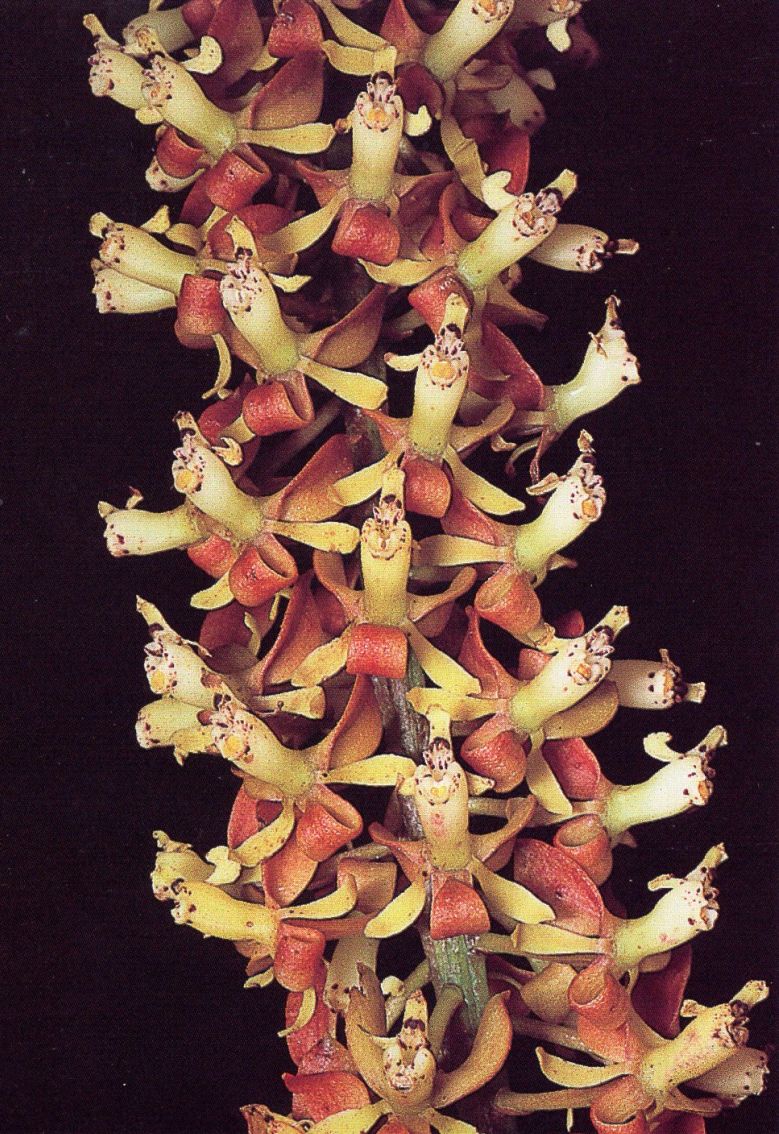

Epidendrum parvilabre Lindl. 1845 GROUP Cylindraceum
Photo by © Alexander Hirtz
Drawing by © M Lopez R and The AMO Herbaria Website
Common Name The Small Lipped Epidendrum
Flower Size .4” [1 cm]
Found in southern Ecuador and northern Peru in shrubby montane forests at elevations of 1900 to 3000 meters as a small to large sized, cold growing epiphyte with simple, cane-like, fleshy, thickened, laterally compressed stems carrying 1 to 2, apical, oblong-elliptic, bilobed, coriaceous, margin finely erose leaves that blooms at any time of the year on a terminal, arising through a single, oblong, acute spathe, racemose, erect below, arching above peduncle with a sheath like, ancipitous bract above the spathe and a smaller acuminate bract near the first flower, simultaneously 20 to 50 flowered inflorescence with much shorter than the ovary, triangular acute floral bracts and carrying resupinate, diurnal herb like fragrant flowers with the sepals and petals creamy green, the column and lip are white and there brown spots on the lip.
Here is a list of the Peruvian Epidendrum with true pseudobulbs, E blepharistes, E compressibulbum, E harmsianum, E microcattleya, E oellgaardii, E parvilabre, E polystachyum, Epidendrum
pseudopolystachum, E rupestre, E saxicola and E viviparum.
"Epidendrum parvilabre belongs to the GROUP Cylindraceum which is characterized by the sympodial habit, few-leaves stems, racemose
inflorescence with 1 to 2, ancipitose, long, spathaceous bracts with parallel sides and resupinate flowers with linear
to linear-spatulate petals and the lateral lobes of the lip falcate. The species is
recognized by the long and wide leaves, 2.8 to 6.4" x .8 to 1.32" [7 to 16 x 2.0 to 3.3 cm), the elongate,
arching, inflorescence, the .28 to .4" [7 to 10 mm] long ovaries and the intermediate sized
flowers, sepals -28 to .44" [7 to 11 mm] long. It closely resembles Epidendrum cylindrostachys
Rchb.f. & Warsc., which has much longer, narrower leaves, 4.8 to 10.8" x .34 to .56" [12 to 27 x 0.9-1.4 cm],
a still longer, narrower, arching inflorescence, with the ovaries shorter, .2 to .28" [5 to 7 mm],
and the flowers smaller, sepals .16 to .28" [4 to 7 mm] long. Epidendrum cylindraceum Lind.,
has shorter, wider leaves, 2.4 to 4" x 1 to 1.4" [6 to 10 x 2.5 to 3.5 cm], a short, compact, erect, stocky
inflorescence, the ovaries notably longer, .48 to .88" [12 to 22 mm], and larger flowers, sepals .4 to .48"
[10 to 12 mm] long. The following two species have somewhat dissimilar flowers:
Epidendrum lřjtnantii Hágsater & Dodson, has successive flowers, narrow
leaves, .72 to .8" [1.8 to 2.0 cm] wide, an unornamented, .48 to .6" [12 to 15 mm] long ovary, the lateral
lobes of the lip crenulate, and the midlobe prominently bilobed. Epidendrum
cylindrostenophyllum Hágsater & Dodson, has fewer, simultaneous flowers,
about 20, narrow leaves, ca. .4" [1 cm] wide, a shorter inflorescence, 6" [15 cm] long, the
shortest ovaries .12 to .2" [3 to 5 mm] long, small flowers, sepals .14 to .2" [3.5 to 5.0 mm] long, lateral
lobes of the lip retrorse and narrow at the base, transversely elliptic at the
rounded apex." Hagsater etal 2009
Synonyms
References W3 Tropicos, Kew Monocot list , IPNI ;
Orchids of Peru Vol 2 Schweinfurth 1959; Icones Plantarum Tropicarum Plate 69 Dodson & Bennett 1989 drawing fide; Native Ecuadorian Orchids vol 2 Dodson 2001 photo fide;
Icones Orchidacearum 4 Plate 455 Hagsater 2001 see recognition section;
Icones Orchidacearum 7 Plate 755 Hagsater and Sanchez 2004 see recognition section;
Icones Orchidacearum 7 Plate 785 Hagsater and Sanchez 2004 see recognition section; Icones Orchidacearum 12 Plate 1234 Hagsater 2009 see recognition section;
Icones Orchidacearum 12 Plate 1271 Hagsater 2009 drawing fide; Orquideas, Tesoro de Colombia Vol 2 Ortiz & Uribe 2017 as E cf parvilabre drawing fide;
--------------------------------------------------------------------------------------------------------------------------

